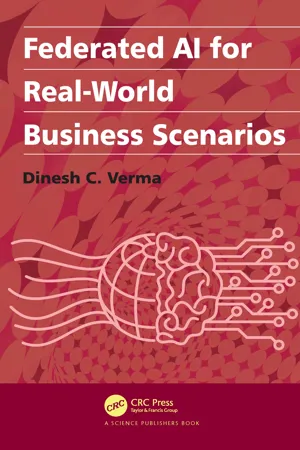
- 206 pages
- English
- ePUB (mobile friendly)
- Available on iOS & Android
Federated AI for Real-World Business Scenarios
About this book
This book provides an overview of Federated Learning and how it can be used to build real-world AI-enabled applications. Real-world AI applications frequently have training data distributed in many different locations, with data at different sites having different properties and different formats. In many cases, data movement is not permitted due to security concerns, bandwidth, cost or regulatory restriction. Under these conditions, techniques of federated learning can enable creation of practical applications. Creating practical applications requires implementation of the cycle of learning from data, inferring from data, and acting based on the inference. This book will be the first one to cover all stages of the Learn-Infer-Act cycle, and presents a set of patterns to apply federation to all stages. Another distinct feature of the book is the use of real-world applications with an approach that discusses all aspects that need to be considered in an operational system, including handling of data issues during federation, maintaining compliance with enterprise security policies, and simplifying the logistics of federated AI in enterprise contexts. The book considers federation from a manner agnostic to the actual AI models, allowing the concepts to be applied to all varieties of AI models. This book is probably the first one to cover the space of enterprise AI-based applications in a holistic manner.
Frequently asked questions
- Essential is ideal for learners and professionals who enjoy exploring a wide range of subjects. Access the Essential Library with 800,000+ trusted titles and best-sellers across business, personal growth, and the humanities. Includes unlimited reading time and Standard Read Aloud voice.
- Complete: Perfect for advanced learners and researchers needing full, unrestricted access. Unlock 1.4M+ books across hundreds of subjects, including academic and specialized titles. The Complete Plan also includes advanced features like Premium Read Aloud and Research Assistant.
Please note we cannot support devices running on iOS 13 and Android 7 or earlier. Learn more about using the app.
Information
Appendices
Appendix 1: Frameworks for Federated Learning
Appendix 2: Adversarial Federated Learning
References
- S. Legg, M. Hutter, et al., “A collection of definitions of intelligence,” in Frontiers in Artificial Intelligence and Applications, vol. 157, p. 17, IOS Press, 2007.
- C. Grosan and A. Abraham, “Rule-based expert systems,” in Intelligent Systems, pp. 149–185, 2011.
- G. Cirincione and D. Verma, “Federated Machine Learning for Multi-Domain Operationsat the tactical edge,” in Artificial Intelligence and Machine Learning for Multi-Domain Operations Applications, vol. 11006, p. 1100606, International Society for Optics and Photonics, 2019.
- W. D. Nothwang, M. J. McCourt, R. M. Robinson, S. A. Burden, and J. W. Curtis, “The human should be part of the control loop?,” in 2016 Resilience Week (RWS), pp. 214–220, IEEE, 2016.
- G. A. Seber and A. J. Lee, Linear Regression Analysis, vol. 329. John Wiley & Sons, 2012.
- D. G. Kleinbaum, K. Dietz, M. Gail, M. Klein, and M. Klein, Logistic Regression. Springer, 2002.
- L. Atzori, A. Iera, and G. Morabito, “The internet of things: A survey,” Computer Networks, vol. 54, no. 15, pp. 2787–2805, 2010.
- R. Kohavi, “The power of decision tables,” in European Conference on Machine Learning, pp. 174–189, Springer, 1995.
- L. Rokach and O. Maimon, “Decision trees,” in Data Mining and Knowledge Discovery Handbook, pp. 165–192, Springer, 2005.
- C. Feng and D. Michie, “Machine learning of rules and trees,” Machine Learning, Neural and Statistical Classification, pp. 50–83, 1994.
- M. A. Nielsen, Neural Networks and Deep Learning, vol. 2018. Determination Press San Francisco, CA, 2015.
- C. C. Aggarwal, Neural Networks and Deep Learning. Springer, 2018.
- H. Abdi and L. J. Williams, “Principal component analysis,” Wiley Interdisciplinary Reviews: Computational Statistics, vol. 2, no. 4, pp. 433–459, 2010.
- H. Abdi and D. Valentin, “Multiple correspondence analysis,” Encyclopedia of Measurement and Statistics, vol. 2, no. 4, pp. 651–657, 2007.
- S. Suthaharan, “Support vector machine,” in Machine Learning Models and Algorithms for Big Data Classification, pp. 207–235, Springer, 2016.
- B. Steffen, F. Howar, and M. Merten, “Introduction to active automata learning from a practical perspective,” in International School on Formal Methods for the Design of Computer, Communication and Software Systems, pp. 256–296, Springer, 2011.
- J. G. Kemeny and J. L. Snell, Markov Chains. Springer-Verlag, New York, 1976.
- L. Rabiner and B. Juang, “An introduction to Hidden Markov Models,” IEEE ASSP Magazine, vol. 3, no. 1, pp. 4–16, 1986.
- T. Murata, “Petri Nets: Properties, Analysis and Applications,” Proceedings of the IEEE, vol. 77, n...
Table of contents
- Cover
- Title Page
- Copyright Page
- Dedication
- Preface
- Table of Contents
- Introduction to Artificial Intelligence
- Scenarios for Federated AI
- Naive Federated Learning Approaches
- Addressing Data Mismatch Issues in Federated AI
- Addressing Data Skew Issues in Federated Learning
- Addressing Trust Issues in Federated Learning
- Addressing Synchronization Issues in Federated Learning
- Addressing Vertical Partitioning Issues in Federated Learning
- Use Cases
- Appendix 1: Frameworks for Federated Learning
- Appendix 2: Adversarial Federated Learning
- References
- Index